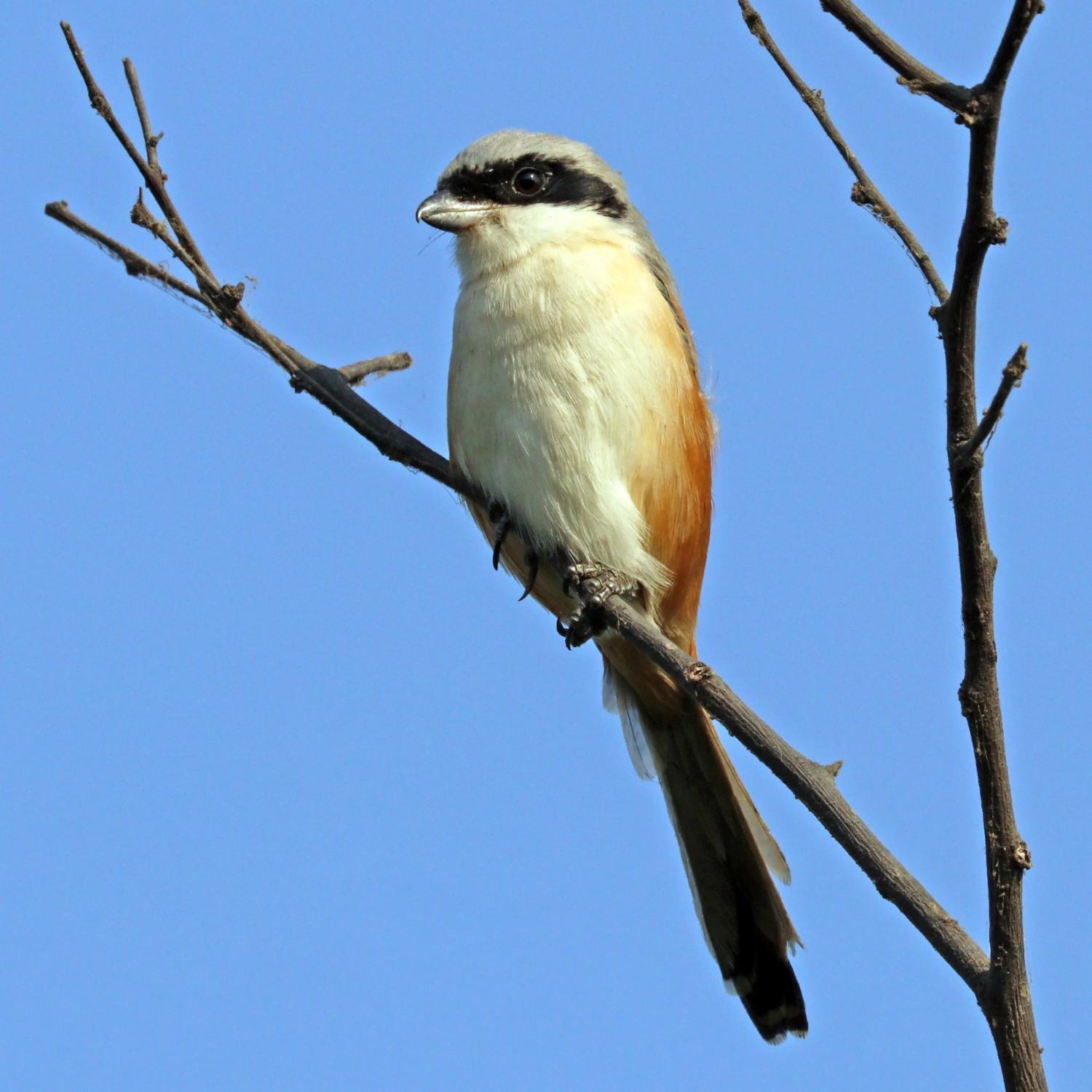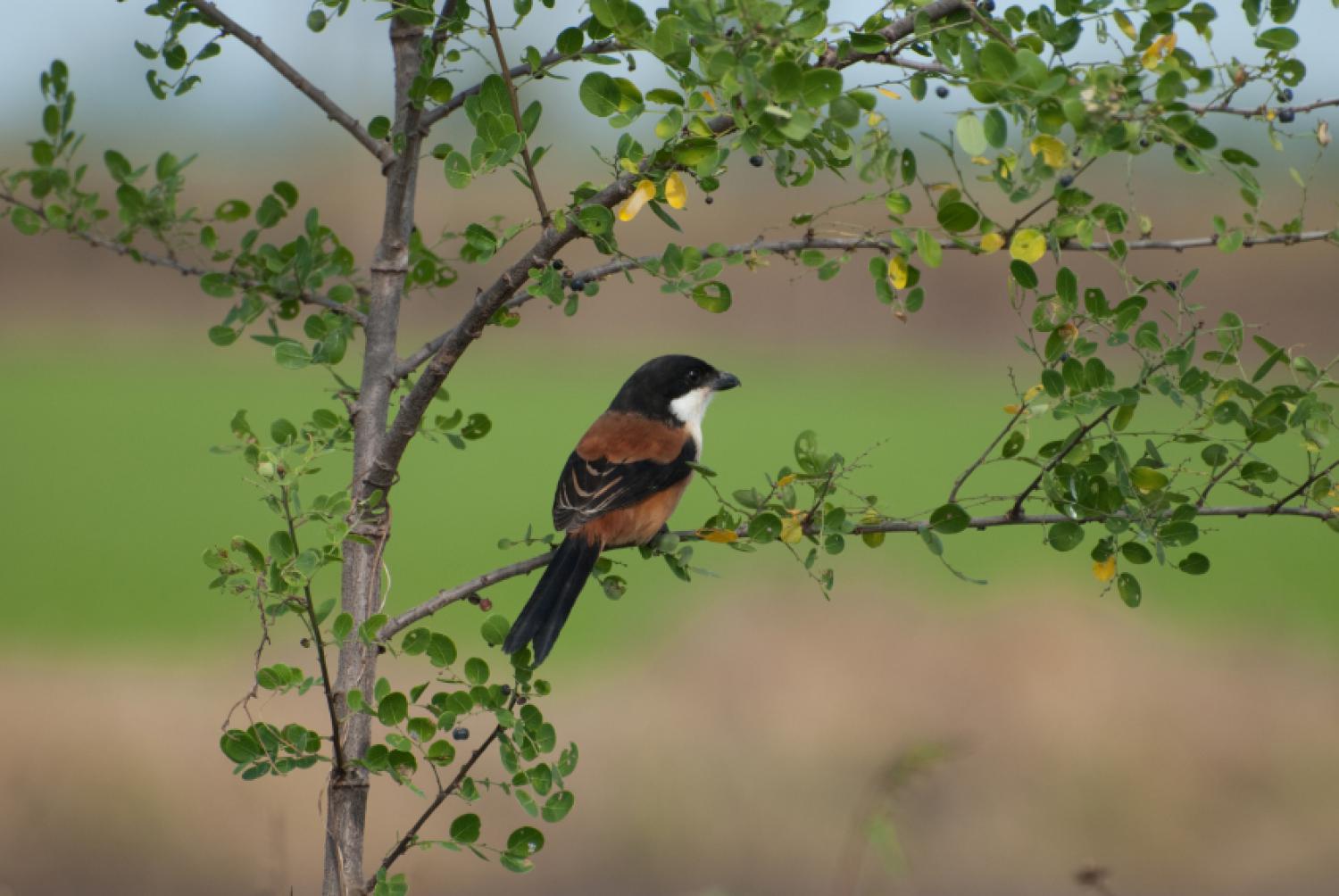Species of Thailand
Long-tailed shrike
Lanius schach
Carolus Linnaeus, 1758
In Thai: นกอีเสือหัวดำ
The long-tailed shrike or rufous-backed shrike (Lanius schach) is a member of the bird family Laniidae, the shrikes. They are found widely distributed across Asia and there are variations in plumage across the range. The species ranges across much of Asia, both on the mainland and the eastern archipelagos. The eastern or Himalayan subspecies, L. s. tricolor, is sometimes called the black-headed shrike. Although there are considerable differences in plumage among the subspecies, they all have a long and narrow black tail, have a black mask and forehead, rufous rump and flanks and a small white patch on the shoulder. It is considered to form a superspecies with the grey-backed shrike (Lanius tephronotus) which breeds on the Tibetan Plateau.
Description
The long-tailed shrike is a typical shrike, favouring dry open habitats and found perched prominently atop a bush or on a wire. The dark mask through the eye is broad and covers the forehead in most subspecies and the whole head is black in subspecies tricolor and nasutus. The tail is narrow and graduated with pale rufous on the outer feathers. Subspecies erythronotus has the grey of the mantle and upper back suffused with rufous while the southern Indian caniceps has pure grey. A small amount of white is present at the base of the primaries. The bay-backed shrike is smaller and more contrastingly patterned and has a more prominent white patch on the wing. The sexes are alike in plumage.
Taxonomy
The genus name, Lanius, is derived from the Latin word for "butcher", and some shrikes are also known as "butcher birds" because of their feeding habits. The specific schach is an onomatopoeic name based on the call. The common English name "shrike" is from Old English scríc, "shriek", referring to the shrill call.
A number of subspecies are noted within the widely distributed range of this species. Stuart Baker in the second edition of The Fauna of British India considered Lanius schach, Lanius tephronotus and Lanius tricolor as three species. He considered nigriceps as synonymous with tricolor and included erythronotus as a race of schach. Other treatments were proposed by Hugh Whistler and N B Kinnear where tephronotus was considered a subspecies of schach and nigriceps and nasutus grouped together. Another treatment considered tricolor as a subspecies of L. tephronotus. It was subsequently however noted that tephronotus and schach co-occurred in the Kumaon region and so the two were confirmed as distinct species. Molecular distances also indicate that they are distant enough. The erythronotus group have a grey head which continues into the back with a gradual suffusion of rufous. The westernmost population from Transcaspia named by Sergei Buturlin as jaxartensis and said to be larger, is not considered valid. A very light grey form from western dry region of India named by Walter Koelz as kathiawarensis is also considered merely as a variant. In southern India and Sri Lanka, subspecies caniceps, is marked by the rufous restricted to the rump, light crown and the pure grey on the back. Biswamoy Biswas supported the view that nigriceps (having upper mantle grey and lower mantle rufous) was a hybrid of tricolor and erythronotus.
Subspecies longicaudatus has a greyer crown and is found in Thailand and Burma. The nominate subspecies is found in China from the Yangtze valley south to Hainan and Taiwan. Some individuals of the nominate form show melanism and were once described as a species fuscatus. Island forms include nasutus (Philippine Islands from Mindanao to Luzon and north Borneo), suluensis (Sulu Island), bentet (Sunda Islands and Sumatra other than Borneo) and stresemanni of New Guinea.
Distribution and habitat
The species is found across Asia from Kazakhstan to New Guinea. It is found mainly in scrub and open habitats. Many of the temperate zone populations are migratory, moving south in winter while those in the tropics tend to be sedentary although they may make short distance movements. Subspecies caniceps of southern India is found in winter in the dry coastal zone of southern India. Subspecies tricolor migrates south to Bengal in India. They are found in scrub, grassland and open land under cultivation. A survey in southern India found them to be among the commonest wintering shrikes and found at a linear density along roadsides at about 0.58 per kilometer, often choosing wires to perch.
This species is a rare vagrant to western Europe on the strength of two accepted records in Great Britain on South Uist in November 2000 and the Netherlands near Den Helder in October 2011. A bird matching the features of caniceps was seen on the island of Maldives. It has also occurred as a vagrant to Jordan, Israel, Turkey, Hungary, Japan and Sweden.
Behaviour and ecology
This bird has a characteristic upright "shrike" attitude when perched on a bush, from which it glides down at an angle to take lizards, large insects, small birds and rodents. They maintain feeding territories and are usually found single or in pairs that are well spaced out. Several members have been observed indulging in play behaviour fighting over perches. The usual calls are harsh grating and scolding calls, likened to the squealing of a frog caught by a snake. They are capable of vocal mimicry and include the calls of many species including lapwings, cuckoos, puppies and squirrels in their song. This singing ability makes it a popular pet in parts of southeast Asia.
Long-tailed shrikes take a wide variety of animal prey. On occasion, they have been noted capturing fish from a stream. They also take small snakes. It sometimes indulges in kleptoparasitism and takes prey from other birds. It also captures flying insects in the air. They sometimes impale prey on a thorny bush after feeding just on the head or brain. They have been reported to feed on the fruits of the neem in Kerala, even attempting to impale them on a twig.
The breeding season is in summer in the temperate ranges. The nest is a deep and loose cup made up of thorny twigs, rags and hair. This is placed in a thorny bush, trees such as Flacourtia and wild date palms (Phoenix). The usual clutch is about 3 to 6 eggs which are incubated by both sexes. The eggs hatch after about 13 to 16 days. Young chicks are often fed with pieces of small birds captured by the parents. A second brood may be raised in the same nest. They are sometimes parasitized by cuckoos such as the common cuckoo (Dehra Dun), common hawk-cuckoo, Jacobin cuckoo and the Asian koel in Bangladesh.
This article uses material from Wikipedia released under the Creative Commons Attribution-Share-Alike Licence 3.0. Eventual photos shown in this page may or may not be from Wikipedia, please see the license details for photos in photo by-lines.
Category / Seasonal Status
Wiki listed status (concerning Thai population): Passage migrant
BCST Category: Recorded in an apparently wild state within the last 50 years
BCST Seasonal statuses:
- Resident or presumed resident
- Non-breeding visitor
Scientific classification
- Kingdom
- Animalia
- Phylum
- Chordata
- Class
- Aves
- Order
- Passeriformes
- Family
- Laniidae
- Genus
- Lanius
- Species
- Lanius schach
Common names
- Thai: นกอีเสือหัวดำ
Conservation status

Least Concern (IUCN3.1)

Least Concern (ONEP)
- LC/EN (longicaudatus) -
Photos
Please help us review the bird photos if wrong ones are used. We can be reached via our contact us page.
Range Map

- Ban Chang District, Rayong
- Ban Laem District, Phetchaburi
- Ban Phai District, Khon Kaen
- Bang Pa In District, Phra Nakhon Si Ayutthaya
- Bang Phra Non-Hunting Area
- Bang Pu Recreation Centre
- Bangkok Province
- Bueng Boraped Non-Hunting Area
- Chatturat District, Chaiyaphum
- Chiang Dao District, Chiang Mai
- Chiang Dao Wildlife Sanctuary
- Chiang Khong District, Chiang Rai
- Chiang Saen District, Chiang Rai
- Doi Inthanon National Park
- Doi Lang
- Doi Lo District, Chiang Mai
- Doi Pha Hom Pok National Park
- Doi Saket District, Chiang Mai
- Doi Suthep - Pui National Park
- Doi Tao District, Chiang Mai
- Fang District, Chiang Mai
- Hang Chat District, Lampang
- Hat Yai District, Songkhla
- Huai Chorakhe Mak Reservoir Non-Hunting Area
- Huai Nam Dang National Park
- Kabin Buri District, Prachinburi
- Kaeng Khoi District, Saraburi
- Kaeng Krachan National Park
- Kamphaeng Saen District, Nakhon Pathom
- Kantharawichai District, Maha Sarakham
- Khao Sam Roi Yot National Park
- Khao Sanam Prieng Wildlife Sanctuary
- Khao Soi Dao Wildlife Sanctuary
- Khao Yai National Park
- Khao Yoi District, Phetchaburi
- Khon San District, Chaiyaphum
- Ko Chang National Park
- Kumphawapi District, Udon Thani
- Laem Pak Bia
- Lam Nam Kok National Park
- Mae Ai District, Chiang Mai
- Mae Chan District, Chiang Rai
- Mae Fa Luang District, Chiang Rai
- Mae Mo District, Lampang
- Mae Ping National Park
- Mae Rim District, Chiang Mai
- Mae Taeng District, Chiang Mai
- Mae Wong National Park
- Mueang Chachoengsao District, Chachoengsao
- Mueang Chiang Mai District, Chiang Mai
- Mueang Chiang Rai District, Chiang Rai
- Mueang Khon Kaen District, Khon Kaen
- Mueang Lampang District, Lampang
- Mueang Lamphun District, Lamphun
- Mueang Nakhon Nayok District, Nakhon Nayok
- Mueang Phayao District, Phayao
- Mueang Phetchaburi District, Phetchaburi
- Mueang Phichit District, Phichit
- Mueang Phitsanulok District, Phitsanulok
- Mueang Ratchaburi District, Ratchaburi
- Mueang Samut Sakhon District, Samut Sakhon
- Mueang Sukhothai District, Sukhothai
- Mueang Suphanburi District, Suphan Buri
- Mueang Uttaradit District, Uttaradit
- Nam Nao National Park
- Non Thai District, Nakhon Ratchasima
- Nong Bong Khai Non-Hunting Area
- Pa Sang District, Lamphun
- Pai District, Mae Hong Son
- Pak Chong District, Nakhon Ratchasima
- Pak Phli District, Nakhon Nayok
- Pak Thale
- Pang Tong Royal Forest Park
- Pha Daeng National Park
- Phanat Nikhom District, Chonburi
- Phra Nakhon Si Ayutthaya District, Phra Nakhon Si Ayutthaya
- Phu Chi Fa Forest Park
- Phu Hin Rong Kla National Park
- Phutthamonthon District, Nakhon Pathom
- Pran Buri District, Prachuap Khiri Khan
- Ramkhamhaeng National Park
- Samut Prakan Province
- San Sai District, Chiang Mai
- Taphan Hin District, Phichit
- Tha Takiap District, Chachoengsao
- Thanyaburi District, Pathum Thani
- Thap Lan National Park
- Wang Noi District, Phra Nakhon Si Ayutthaya
- Wat Phai Lom & Wat Ampu Wararam Non-Hunting Area
- Wiang Chai District, Chiang Rai
- Wiang Kaen District, Chiang Rai



